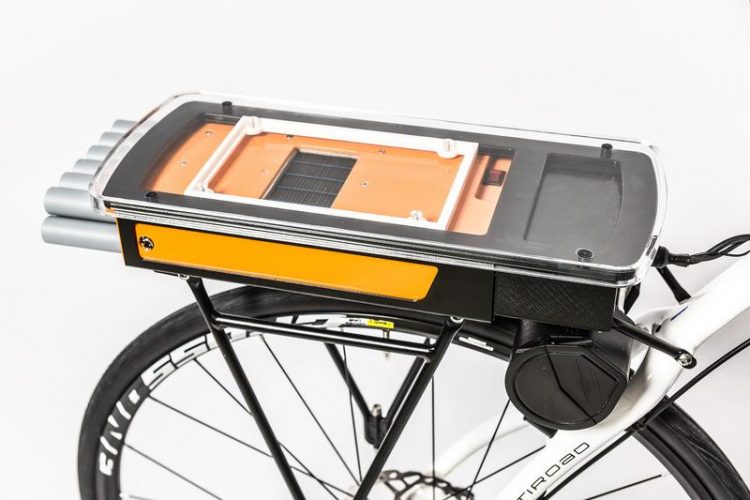Fraunhofer ISE Presents Hydrogen Technologies at Hannover Trade Fair

The electric bicycle rack with fuel cell only weighs 3.3 kg including hydrogen tank. It can be mounted on any bike. Fraunhofer ISE
LiteFCBike: Lightweight Fuel Cell System replaces Battery
The market for e-bikes and pedelecs as sustainable alternatives to cars has steadily increased over the past years. In the LiteFCBike project https://www.ise.fraunhofer.de/en/research-projects/litefcbike.html, Fraunhofer ISE develops a compact fuel cell system that replaces the secondary battery.
The technology is based on the power train Conodrive, a lightweight, replaceable power train that powers the rear wheel with a special drive roller. The project objective was to develop a light and practical system together with the developer of Conodrive, José Fernandez.
This was achieved with polymer electrolyte membrane fuel cells, or PEMFC, a fuel cell type that is typically used in automobiles. To reduce weight and volume, two fuel cell stacks with open cathodes were used, thus making a liquid cooling system unnecessary.
In order to fluidically connect all components, the researchers developed a compact fluidic module in which all components are connected. As a result, no pipes and connectors are needed. Metal hydride cartridges are used as storage. They are easily available and can be refilled by the user with a suitable small electrolyzer.
By using a larger hydrogen storage, one could realize longer ranges. In order to achieve significantly greater ranges and maintain short refueling times, it would be possible to use a pressurized storage.
In nominal operation, the fuel cells produce circa 70 Watt and charge the buffer storage. In the supportive phase, 250 watts are available, which is the usual amount for a pedelec. The total volume of the complete system, including tank and controls, is 348 x 153 x 47 mm³. The net energy content of one tank filling is about 270 Wh.
Power-to-Hydrogen: hydrogen as a flexible energy carrier
Hydrogen is a key technology for the transformation of our energy system. As seasonal storage of wind and solar electricity in the form of chemical energy, hydrogen can be used in the heat, transport, industry and mobility sectors. Fraunhofer ISE demonstrates two of the manifold possibilities for using hydrogen in the energy system in the practice: an on-site hydrogen feed-in plant and an on-site solar hydrogen refueling station.
With a PEM electrolyzer, electricity is used to split water and produce hydrogen, which is then stored in pressurized tanks or discharged directly into the respective sectors. At the solar hydrogen refueling station, cars and busses can be filled with renewable fuel. The hydrogen feed-in plant supplies the gas network with renewable gas.
Fraunhofer ISE uses the systems as research platforms to test sector coupling approaches, new components for hydrogen and natural gas applications and new operation strategies for electrolysis, refueling stations and feed-in systems. Clients can test their own product developments at Fraunhofer ISE’s on-site hydrogen systems as a first-time field implementation.
With its pilot series, test facilities and technology evaluation centers, Fraunhofer ISE offers technology developments from functional models up to the transfer to production. The service offers comprise of studies for new concepts, development of processes and process chains, customization of systems and components, characterization, modeling, simulation and technology evaluations, including techno-economic and environmental assessments. The client profits from the services in the areas of technology development, material development, process development, Membrane electrode assembly (MEA) characterization and technology evaluation.
Talks Presented by Fraunhofer ISE Researchers:
Integrated Energy Forum (Hall 27, Booth L55)
Monday, April 1st
16:15 Hans-Martin Henning, Director Fraunhofer ISE: “Comprehensive system integration: technical, economic, social – the Kopernikus project Enavi”
Technical Forum (Hall 27)
Tuesday, April 2
14:00 Max Julius Hadrich: “Pathways for Power-to-Liquid fuels and Chemicals”
Wednesday, April 3
13:00 Ulf Groos: “Characterization of Fuel Cell MEAs”
Thursday, April 4
11:20 Stefan Keller: “Advanced Characterization of Fuel Cell Stacks”
16:00 Thomas Jungmann: “Testing of Fuel Cell BoP Components in H2 Atmosphere”
https://www.ise.fraunhofer.de/en/press-media/press-releases/2019/fraunhofer-ise-…
Media Contact
All latest news from the category: Trade Fair News
Newest articles

NASA: Mystery of life’s handedness deepens
The mystery of why life uses molecules with specific orientations has deepened with a NASA-funded discovery that RNA — a key molecule thought to have potentially held the instructions for…

What are the effects of historic lithium mining on water quality?
Study reveals low levels of common contaminants but high levels of other elements in waters associated with an abandoned lithium mine. Lithium ore and mining waste from a historic lithium…

Quantum-inspired design boosts efficiency of heat-to-electricity conversion
Rice engineers take unconventional route to improving thermophotovoltaic systems. Researchers at Rice University have found a new way to improve a key element of thermophotovoltaic (TPV) systems, which convert heat…



